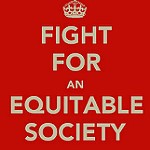Widgetized Section
Go to Admin » Appearance » Widgets » and move Gabfire Widget: Social into that MastheadOverlay zone
A Primer for Effective and Meaningful Social Equity Measurement
The views expressed are those of the author and do not necessarily reflect the views of ASPA as an organization.
By Tia Gaynor
March 7, 2017
The American Society of Public Administration’s Center for Accountability and Performance, in collaboration with the National Academy of Public Administration’s Social Equity in Governance standing panel, sponsored two teams of research fellows to develop projects with the goal of advancing knowledge and sharing practices in the measurement of social equity. Each team presented their research findings in an online ASPA webinar held Thursday, February 23, 2017.
 I, along with my colleagues Dr. Brandi Blessett (Rutgers University – Camden, NJ) and Dr. Marc Fudge (California State University – San Bernardino, CA), served as one of those two teams. During our research for the project, we were able to identify a number of interesting strategies in the meaningful measurement of equity that are currently being employed by local governments and community organizations. We found the initiatives we identified are rare and social equity, as a performance measure, is not fully integrated in the practice of public administration.
I, along with my colleagues Dr. Brandi Blessett (Rutgers University – Camden, NJ) and Dr. Marc Fudge (California State University – San Bernardino, CA), served as one of those two teams. During our research for the project, we were able to identify a number of interesting strategies in the meaningful measurement of equity that are currently being employed by local governments and community organizations. We found the initiatives we identified are rare and social equity, as a performance measure, is not fully integrated in the practice of public administration.
Theoretically, social equity is considered a foundational element to the study and practice of public administration. The practical implementation of practices that foster, strengthen and maintain equitable outcomes however, are not universal to the daily operations of administrators in the United States. Even when social equity indicators are included in performance they often, by large margins, fall behind effectiveness and efficiency. The lack of a universal definition and a clear method for measuring social equity leaves administrators without an operational guide for assessment. In this respect, we have developed what we call an evolved definition of social equity. This definition builds upon the work of Drs. Susan Gooden, Blue Wooldridge, Jim Svara and Norman Johnson (among others) to offer a definition of social equity directly linked with measureable concepts.
Social equity, in public administration, refers to policy formulation and implementation, public management practices, the provision of public goods and services and administrator/resident interactions that reduce (and ultimately eliminate) disparity, marginalization and discrimination while increasing social and political inclusion.
Our definition intentionally avoids terms like “fairness” and “equality.” There are two reasons for this:
- Fairness is subjective and, when considering measureable concepts, is difficult to measure; and
- Equality suggests disparities can be eradicated through redistribution.
The equality argument is based on an ideology grounded within the assumption that everyone starts from the same place. The evolved definition does, however, incorporate measureable concepts like disparity, discrimination, marginalization and inclusion. These concepts are measureable, are not broadly defined or interpreted, and (when measured) aids agencies and administrators in the determination of policy, program, behavioral and organizational impacts on issues of equity.
In the final report, we offer several considerations for strengthening the meaningful measurement of social equity in public and nonprofit organizations:
- Be deliberate in considering how actions, programs and policies impact different social groups. Even the most comprehensive approach to social equity measurement will not be as effective and beneficial to the widest range of stakeholders if it is not conscious of the impacts to marginalized populations.
- Organizations must develop a culture that values social equity. A culture which values issues of equity dedicates resources (human and financial) to develop sound strategies to implement highly comprehensive approaches for social equity measurement.
- Effective and meaningful social equity practices are not void of historical and social context. Considerations of both historical and social contexts offer meaning to measurement data and a clearer picture for administrators to evaluate and understand shifts in equity. An evaluation of data that excludes context is limited in its breadth and depth of understanding how and why change occurs.
Ultimately, it is only when equity is experienced by those who are most marginalized, underrepresented or not represented that true social equity is achieved.
A more robust discussion of each of the research projects will be had at this year’s ASPA conference in Atlanta, GA. During this session, representatives from each research team will be presenting their project and research findings.
Author: Tia Sherèe Gaynor (preferred pronouns she/her/hers) is an assistant professor in the Department of Public and Nonprofit Administration at Marist College. Dr. Gaynor’s research examines issues of social justice and equity within a U.S. and global context. Her scholarship can be categorized as follows: resident participation and engagement; public and social policy analysis and implementation; and pedagogy, learning and instruction. Email: [email protected].



 (7 votes, average: 3.71 out of 5)
(7 votes, average: 3.71 out of 5)
Follow Us!